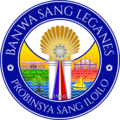Leganes | |
|---|---|
| Municipality of Leganes | |
 Municipal Hall, 2023 | |
 Map of Iloilo with Leganes highlighted | |
Location within the Philippines | |
| Coordinates: 10°47′N122°35′E / 10.78°N 122.58°E | |
| Country | Philippines |
| Region | Western Visayas |
| Province | Iloilo |
| District | 2nd district |
| Founded | 1584 |
| Chartered | 1858 |
| Barangays | 18 (see Barangays) |
| Government | |
| • Type | Sangguniang Bayan |
| • Mayor | Vicente P. Jaen II (NP) |
| • Vice Mayor | Lyle L. Bartolome (NP) |
| • Representative | Kathryn Joyce F. Gorriceta (Lakas) |
| • Municipal Council | Members |
| • Electorate | 24,755 voters (2025) |
| Area | |
• Total | 32.20 km2 (12.43 sq mi) |
| Elevation | 6.0 m (19.7 ft) |
| Highest elevation | 39 m (128 ft) |
| Lowest elevation | −1 m (−3.3 ft) |
| Population (2024 census) [3] | |
• Total | 36,542 |
| • Density | 1,135/km2 (2,939/sq mi) |
| • Households | 8,145 |
| Economy | |
| • Income class | 2nd municipal income class |
| • Poverty incidence | 10.6 |
| • Revenue | ₱ 204.7 million (2022) |
| • Assets | ₱ 536.9 million (2022) |
| • Expenditure | ₱ 146.2 million (2022) |
| • Liabilities | ₱ 123 million (2022) |
| Service provider | |
| • Electricity | Iloilo 1 Electric Cooperative (ILECO 1) |
| Time zone | UTC+8 (PST) |
| ZIP code | 5003 |
| PSGC | |
| IDD : area code | +63 (0)33 |
| Native languages | Hiligaynon Karay-a Tagalog |
| Website | www |
Leganes, officially the Municipality of Leganes (Hiligaynon : Banwa sang Leganes, Tagalog : Bayan ng Leganes), is a municipality in the province of Iloilo, Philippines. According to the 2024 census, it has a population of 36,542 people. [5]
Contents
- History
- Geography
- Barangays
- Climate
- Demographics
- Language
- Religion
- Economy
- References
- External links
Like most Philippine towns that sprawl outward from the capital, is made up of houses, farms and light agricultural industry. The major thoroughfare runs right through the center of the town.




